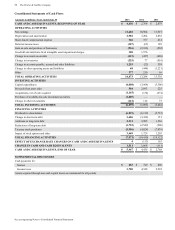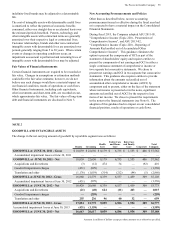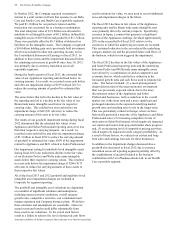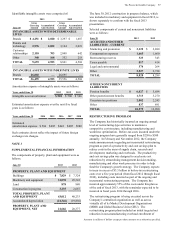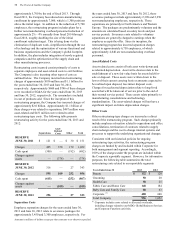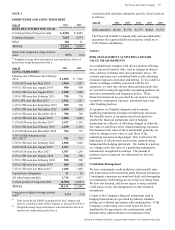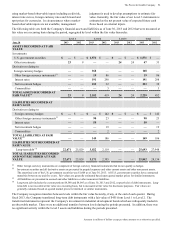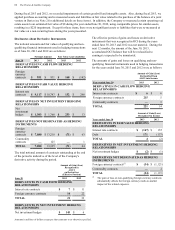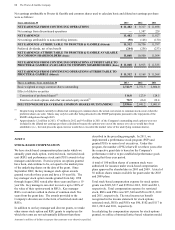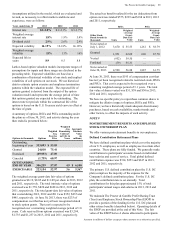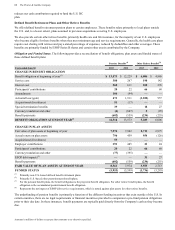Proctor and Gamble 2013 Annual Report Download - page 62
Download and view the complete annual report
Please find page 62 of the 2013 Proctor and Gamble annual report below. You can navigate through the pages in the report by either clicking on the pages listed below, or by using the keyword search tool below to find specific information within the annual report.60 The Procter & Gamble Company
Amounts in millions of dollars except per share amounts or as otherwise specified.
arrangements. The aggregate fair value of the instruments
covered by these contractual features that are in a net
liability position as of June 30, 2013, was not material. The
Company has not been required to post collateral as a result
of these contractual features.
Interest Rate Risk Management
Our policy is to manage interest cost using a mixture of
fixed-rate and variable-rate debt. To manage this risk in a
cost-efficient manner, we enter into interest rate swaps
whereby we agree to exchange with the counterparty, at
specified intervals, the difference between fixed and variable
interest amounts calculated by reference to a notional
amount.
Interest rate swaps that meet specific accounting criteria are
accounted for as fair value or cash flow hedges. For fair
value hedges, the changes in the fair value of both the
hedging instruments and the underlying debt obligations are
immediately recognized in interest expense. For cash flow
hedges, the effective portion of the changes in fair value of
the hedging instrument is reported in OCI and reclassified
into interest expense over the life of the underlying debt
obligation. The ineffective portion for both cash flow and
fair value hedges, which was not material for any year
presented, was immediately recognized in interest expense.
Foreign Currency Risk Management
We manufacture and sell our products and finance operations
in a number of countries throughout the world. As a result,
we are exposed to movements in foreign currency exchange
rates.
To manage the exchange rate risk primarily associated with
our financing operations, we have historically used a
combination of forward contracts, options and currency
swaps. As of June 30, 2013, we had currency swaps with
maturities up to five years, which are intended to offset the
effect of exchange rate fluctuations on intercompany loans
denominated in foreign currencies. These swaps are
accounted for as cash flow hedges. The effective portion of
the changes in fair value of these instruments is reported in
OCI and reclassified into SG&A and interest expense in the
same period or periods during which the related hedged
transactions affect earnings. The ineffective portion, which
was not material for any year presented, was immediately
recognized in SG&A.
The change in fair values of certain non-qualifying
instruments used to manage foreign exchange exposure of
intercompany financing transactions and certain balance
sheet items subject to revaluation are immediately
recognized in earnings, substantially offsetting the foreign
currency mark-to-market impact of the related exposures.
Net Investment Hedging
We hedge certain net investment positions in foreign
subsidiaries. To accomplish this, we either borrow directly
in foreign currencies and designate all or a portion of the
foreign currency debt as a hedge of the applicable net
investment position or we enter into foreign currency swaps
that are designated as hedges of net investments. Changes in
the fair value of these instruments are recognized in OCI to
offset the change in the value of the net investment being
hedged. Currency effects of these hedges reflected in OCI
were after-tax gains of $156 and $740 in 2013 and 2012,
respectively. Accumulated net balances were after-tax losses
of $3,550 and $3,706 as of June 30, 2013 and 2012,
respectively. The ineffective portion, which was not
material in any year presented, was immediately recognized
in interest expense.
Commodity Risk Management
Certain raw materials used in our products or production
processes are subject to price volatility caused by weather,
supply conditions, political and economic variables and
other unpredictable factors. To manage the volatility related
to anticipated purchases of certain of these materials, we
have historically, on a limited basis, used futures and options
with maturities generally less than one year and swap
contracts with maturities up to five years. As of and during
the year ended June 30, 2013, we did not have material
commodity hedging activity.
Insurance
We self-insure for most insurable risks. However, we
purchase insurance for Directors and Officers Liability and
certain other coverage where it is required by law, by
contract or deemed to be in the best interest of the Company.
Fair Value Hierarchy
Accounting guidance on fair value measurements for certain
financial assets and liabilities requires that financial assets
and liabilities carried at fair value be classified and disclosed
in one of the following categories:
Level 1: Quoted market prices in active markets for
identical assets or liabilities.
Level 2: Observable market-based inputs or unobservable
inputs that are corroborated by market data.
Level 3: Unobservable inputs reflecting the reporting
entity's own assumptions or external inputs from inactive
markets.
When applying fair value principles in the valuation of
assets and liabilities, we are required to maximize the use of
quoted market prices and minimize the use of unobservable
inputs. The Company has not changed its valuation
techniques used in measuring the fair value of any financial
assets or liabilities during the year. Our fair value estimates
take into consideration the credit risk of both the Company
and our counterparties.
When active market quotes are not available for financial
assets and liabilities, we use industry standard valuation
models. Where applicable, these models project future cash
flows and discount the future amounts to a present value




